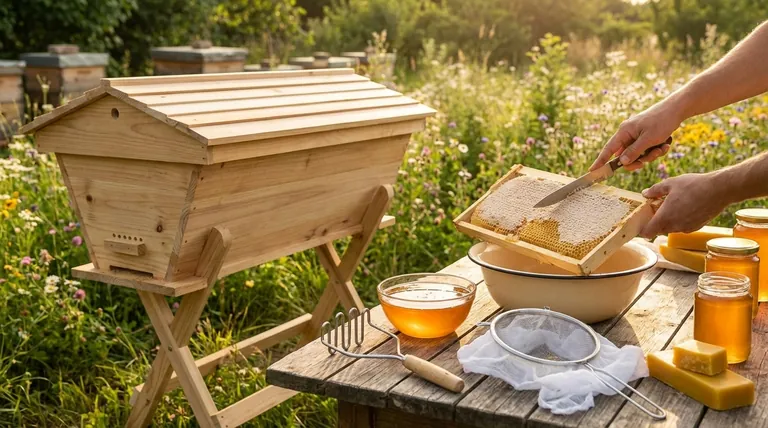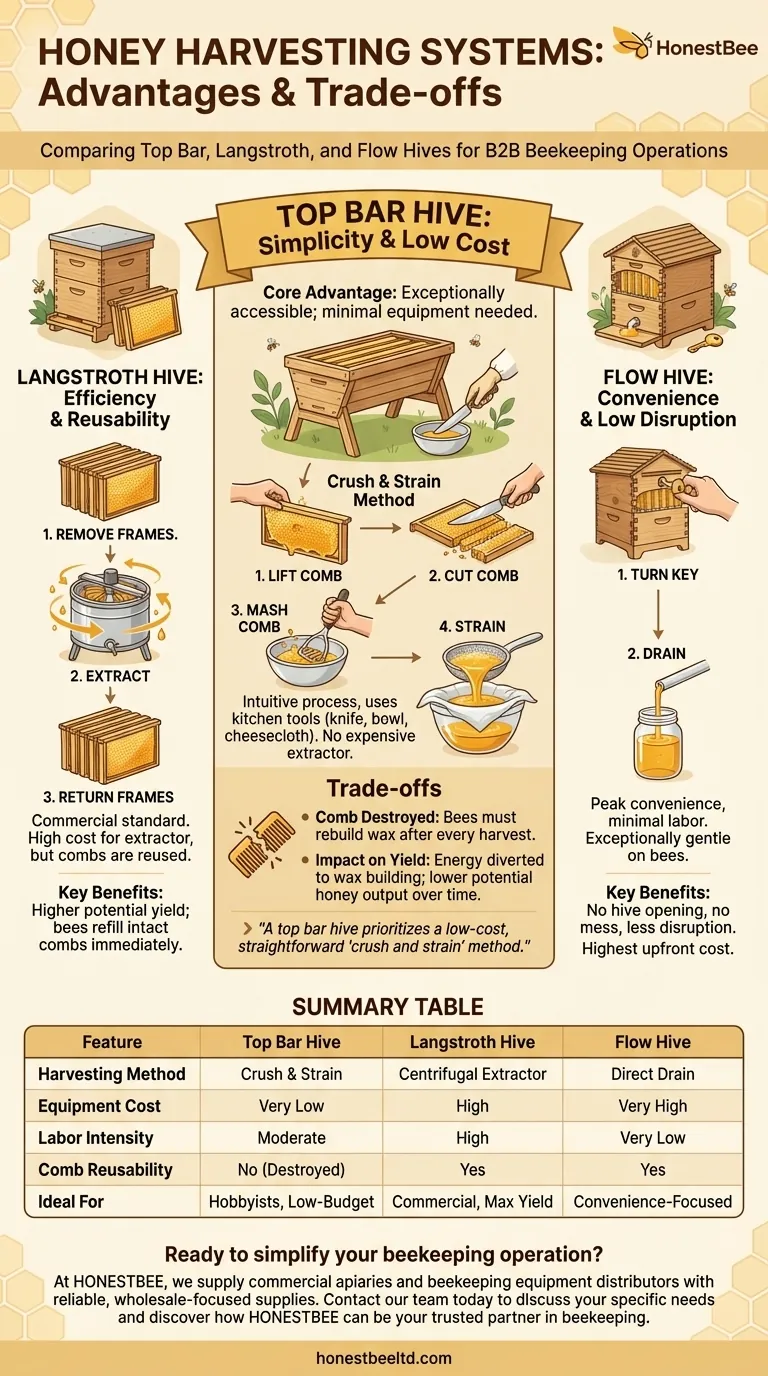At its core, the advantage of using a top bar hive for honey harvesting is its profound simplicity and low cost. Unlike other systems that can require expensive and specialized equipment, you can harvest honey from a top bar hive using little more than a knife, a bowl, and some cheesecloth, making it exceptionally accessible for new or hobbyist beekeepers.
The choice of a beehive is fundamentally a choice about your harvesting process. A top bar hive prioritizes a low-cost, straightforward "crush and strain" method, which stands in stark contrast to the equipment-heavy extraction of Langstroth hives or the high-convenience method of Flow Hives.

The Top Bar Hive Harvest: A Simple Breakdown
The harvesting process for a top bar hive is often referred to as "crush and strain." It is a defining feature of this beekeeping style and is intentionally low-tech.
How the Process Works
The harvest is intuitive and requires no special training. You simply lift a honey-filled comb from the hive, cut the comb from the top bar with a knife, and let it fall into a clean, food-grade bucket or bowl.
Once collected, you mash the comb with a tool like a potato masher. This action breaks open the wax cells, releasing the honey.
Finally, you pour the mixture of honey and wax through a strainer or layers of cheesecloth. The honey filters through, leaving you with clean wax, which can be used for candles, balms, or other projects.
The Advantage of Minimal Equipment
This method's primary benefit is the avoidance of high costs. The standard alternative, used for Langstroth hives, involves a centrifugal extractor—a machine that can cost hundreds or even thousands of dollars.
With a top bar hive, your entire harvesting toolkit can be sourced from your kitchen. This drastically lowers the financial barrier to entry for beekeeping.
How This Compares to Other Hive Systems
To fully grasp the advantages of the top bar method, it's essential to understand the alternatives. Each hive is a self-contained system with a unique approach to harvesting.
The Langstroth Hive: Efficiency and Reusability
Langstroth hives are the commercial standard for a reason. A centrifugal extractor spins frames at high speed, flinging honey out while keeping the delicate wax comb intact.
These empty but intact combs are then returned to the hive. Because the bees do not have to expend energy rebuilding the wax structure, they can begin refilling it with honey almost immediately, leading to higher potential yields.
The Flow Hive: Convenience and Low Disruption
The Flow Hive represents the peak of harvesting convenience. It uses specially designed frames that allow honey to be drained directly from the hive into a jar by turning a key.
This process is exceptionally gentle on the bees, as the hive does not need to be opened and the bees are not disturbed. It is the least labor-intensive and messiest method, but it also comes with the highest upfront cost.
Understanding the Trade-offs
The simplicity of top bar hive harvesting is not without its costs. The "crush and strain" method has fundamental consequences that you must consider.
The Comb is Destroyed
The most significant trade-off is that the wax comb is destroyed during the harvest. Bees must expend a tremendous amount of energy and resources to build this comb.
It is estimated that bees consume about eight pounds of honey to produce just one pound of wax.
Impact on Honey Yield
Because the colony must rebuild the comb from scratch after every harvest, its energy is diverted from honey production.
Over time, this can lead to a lower overall honey yield compared to a Langstroth hive where the comb is reused. You are essentially trading potential honey output for lower equipment costs and simplicity.
A Natural Cycle
For beekeepers who prioritize a more "natural" approach, this annual cycle of building and harvesting comb is seen as a feature, not a bug. It ensures a constant renewal of the wax in the hive, which some believe contributes to colony health.
Making the Right Choice for Your Goal
Your ideal hive depends entirely on what you want to achieve with beekeeping. There is no single "best" hive, only the best hive for you.
- If your primary focus is low startup cost and simplicity: The top bar hive is an excellent choice that gets you started with minimal investment.
- If your primary focus is maximizing honey yield for a small business or a large supply: The Langstroth hive with an extractor is the proven, efficient standard.
- If your primary focus is convenience and minimizing bee disturbance: The Flow Hive offers a unique, albeit more expensive, solution that is exceptionally gentle on bees.
Understanding how each system impacts the harvest empowers you to choose the hive that best aligns with your budget, goals, and beekeeping philosophy.
Summary Table:
| Feature | Top Bar Hive | Langstroth Hive | Flow Hive |
|---|---|---|---|
| Harvesting Method | Crush & Strain | Centrifugal Extractor | Direct Drain from Frame |
| Equipment Cost | Very Low | High (Extractor Required) | Very High |
| Labor Intensity | Moderate | High | Very Low |
| Comb Reusability | No (Comb is Destroyed) | Yes | Yes |
| Ideal For | Hobbyists, Low-Budget Beekeepers | Commercial Beekeepers, Maximizing Yield | Convenience-Focused Beekeepers |
Ready to simplify your beekeeping operation?
At HONESTBEE, we supply commercial apiaries and beekeeping equipment distributors with the reliable, wholesale-focused supplies they need to succeed. Whether you're maximizing yield with Langstroth equipment or starting a new venture with a top bar hive, our expertise and product range can support your goals.
Contact our team today to discuss your specific needs and discover how HONESTBEE can be your trusted partner in beekeeping.
Visual Guide

Related Products
- Top Bar Beehive for Beekeeping Wholesales Kenya Top Bar Hive
- Long Langstroth Style Horizontal Top Bar Hive for Wholesale
- HONESTBEE Professional Long Handled Hive Tool with Precision Cutting Blade
- HONESTBEE Professional Multi-Functional Hive Tool with Ergonomic Wood Handle
- HONESTBEE Advanced Ergonomic Stainless Steel Hive Tool for Beekeeping
People Also Ask
- Why are hive inspections easier with Top Bar Hives? Achieve a Calmer, Safer Approach to Beekeeping
- What are the advantages of harvesting honey from a top bar hive? Low-Cost, Simple Harvesting for Beekeepers
- What are the labor requirements for a KTBH vs. Langstroth hive? A Guide for Apiary Efficiency
- Which is better Kenya top bar hive or Langstroth? Choose the Right Hive for Your Goals
- What are the benefits of extra wax production in top bar hives? A Natural Byproduct for Craft & Efficiency



















